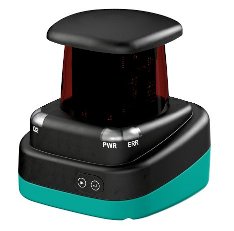This is the documentation of a driver for the Pepperl+Fuchs OMD10M-R2000-B23 laser range finder.
The driver is based upon the widespread boost asio library (http://www.boost.org)
The driver comes as a library, which contains the actual driver, and has additionally a ROS-Node interface to the Robot Operating System (http://www.ros.org), which can be used optionally.
"The new 2-dimensional laser range sensor operates using tried-and-tested Pulse Ranging Technology and boasts a range of unique features. For example, the device features a laser emitter with a visible red light. Users can see where the scanning level is and can align the device accordingly. Thanks to its classification in laser class 1, the device can be used in all workspaces, without posing a health hazard to people. The device has a measuring angle of 360° and boasts a measuring frequency of up to 250,000 individual measurements per second. Combined with a scanning frequency of up to 50 Hz, the device is extremely well suited to highspeed applications. Another feature is the display integrated in the lens aperture." (from the official datasheet with permission from Pepperl+Fuchs)
Official Website: http://www.pepperl-fuchs.com/global/en/classid_53.htm?view=productdetails&prodid=43828#overview
Datasheet (en): http://files.pepperl-fuchs.com/selector_files/navi/productInfo/edb/232934_eng.pdf
The ROS package pepperl_fuchs_r2000 consists of the driver library and a node named r2000_node, which is linked to the library. This is the actual driver node. The dummy_slam_broadcaster is only needed if you want to display the sensors data using the QuickStart method mentioned below.
scan(sensor_msgs/Laserscan) A standard ROS Laserscan message containing the measured data. The message rate per second depends on thescan_frequencyparameter.
frame_idThe frame-ID in the Header of the publishedsensor_msgs/Laserscan2messagesscanner_ipIP or hostname of the laserscannerscan_frequencyThe scan frequency (rotation speed of scanner head) in Hz in the range [10;50]samples_per_scanThe number of distances measured per scan/rotation in the range [72;25200]. Only certain values are allowed (see Manual). Examples are 72, 360, 720, 1440, 1800, 3600, 7200, 10080, 25200.
Copy the driver in your ROS workspace and compile it.
Set the IP-Address of the scanner in pepperl_fuchs_r2000/launch/gui_example.launch and run the following command:
roslaunch pepperl_fuchs_r2000 gui_example.launch
This starts RViz (http://wiki.ros.org/rviz) and the driver and you should see the measuring output of the scanner.
There exists a file CMakeLists.txt.NO_ROS_LIB_ONLY in the pepperl_fuchs_r2000 directory.
Replace CMakeLists.txt with it to compile the driver without ROS:
$ cd pepperl_fuchs_r2000
$ mv CMakeLists.txt.NO_ROS_LIB_ONLY CMakeLists.txt
$ mkdir build
$ cd build
$ cmake ..
$ make
This builds a SHARED library which can be used in your program.
To build a static library remove the SHARED in the add_library command in the CMakeLists.txt.
#include <pepperl_fuchs_r2000/r2000_driver.h>
int main(int argc, char **argv)
{
bool success;
pepperl_fuchs::R2000Driver driver;
success = driver.connect("192.168.0.100"); // Replace IP
success = driver.setScanFrequency(35); // Set scanner frequency in the range [10;50]
success = driver.setSamplesPerScan(3600); // Set samples per scan in the range [72,25200] (valid values are listed in manual)
auto params = driver.getParameters(); // Get all parameter values as std::map<string, string>
for( auto key_value : params )
{ Do something with the parameter values }
success = driver.startCapturingUDP(); // Notice: startCapturingTCP() also exists
while(true)
{
pepperl_fuchs::ScanData scandata = driver.getFullScan(); // Do something with:
scandata.headers; // headers,
scandata.distance_data; // distances and
scandata.amplitude_data; // amplitudes
}
driver.stopCapturing();
driver.disconnect();
}
The driver is commented in doxygen style.
You can create a latex and html documentation in the pepperl_fuchs_r2000/doxygen directory
by entering the following command in the pepperl_fuchs_r2000 directory:
$ doxygen doxygen.conf
